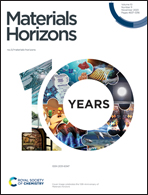0D hybrid indium halide as a highly efficient X-ray scintillation and ultra-sensitive fluorescent probe†
Abstract
Halide perovskite nanocrystal (PNC) of 3D CsPbX3 as a scintillator has aroused intensive attention with advanced applications in radiation detection and X-ray imaging. However, the low light yield and serious toxicity of Pb2+ severely hinder advanced optoelectronic applications. To reduce these fatal shortcomings, a family of new environmentally friendly 0D hybrid lead-free indium halides of [DADPA]InX6·H2O (DADPA = 3,3′-diaminodipropylamine; X = Cl and Br) was prepared. Upon UV excitation, these halides display strong broadband yellow-orange light emissions, and the photoluminescence quantum yield (PLQY) can be optimized up to near unity through the Sb3+-doping strategy. Significantly, high PLQY, negligible self-absorption and low attenuation ability toward X-ray render extraordinary scintillation performance with a high light yield of 51 875 photons MeV−1 and ultralow detection limit of 98.3 nGyair s−1, which is far superior to typical 3D PNC scintillators. Additionally, the ultra-high spatial resolution of 25.15 lp mm−1, negligible afterglow time (2.75 ms) and robust radiant stability demonstrates excellent X-ray imaging performance. To the best of our knowledge, this is the first report on X-ray scintillation based on 0D indium halide materials.



 Please wait while we load your content...
Please wait while we load your content...